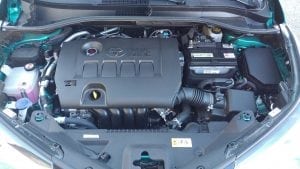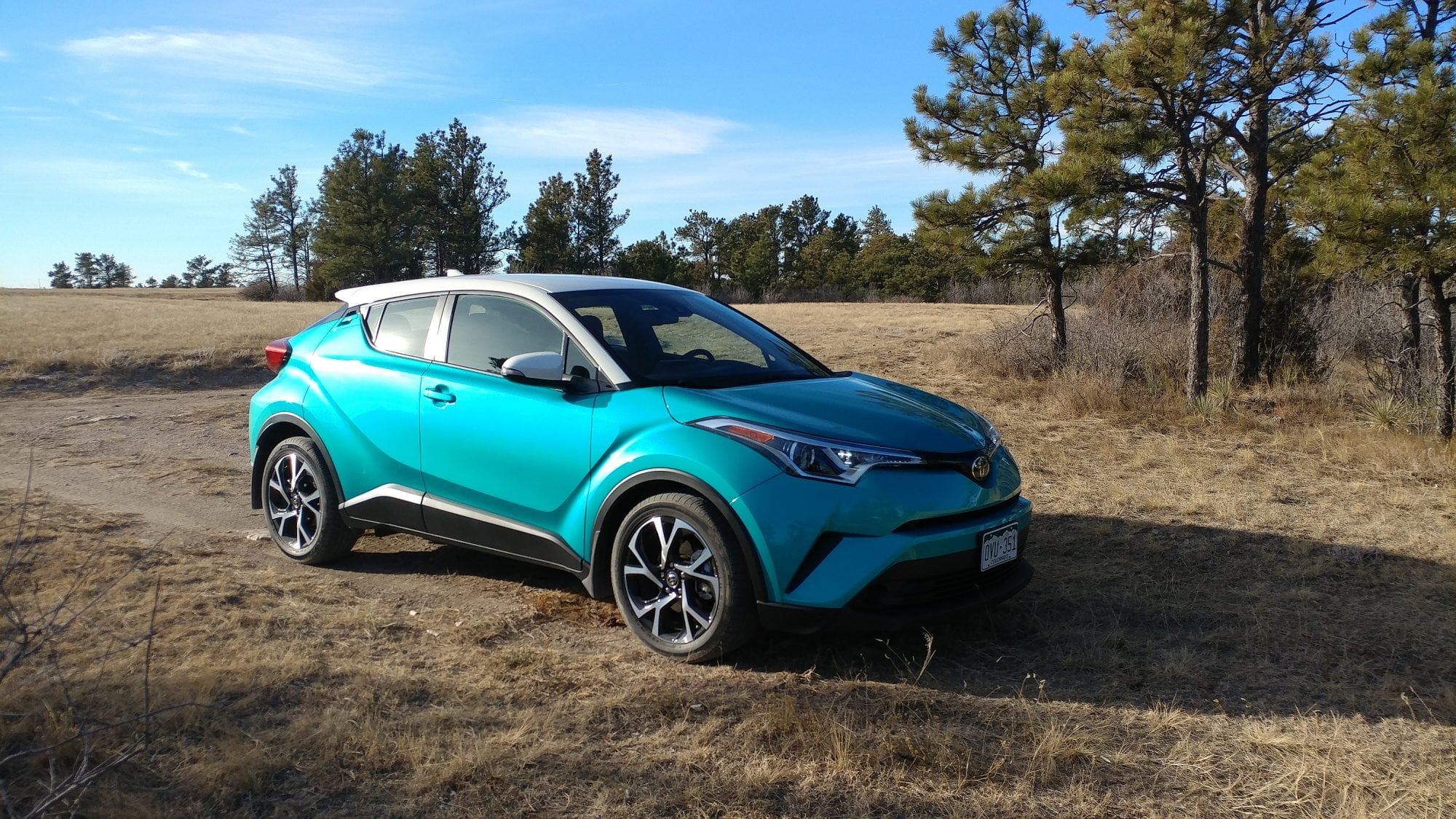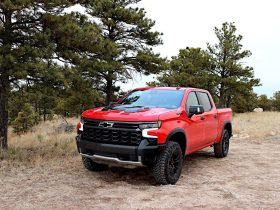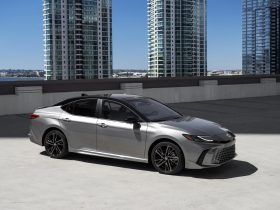The 2018 Toyota C-HR features edgy looks, a roomy interior for its size, and excellent efficiency. It’s not the sportiest drive in the compact crossover market, but it’s got its moments. There are a lot of things to love about this new Toyota offering and we think it’ll find an audience among compact crossover buyers.
Quick Specs & Info |
|||
| 2018 Toyota C-HR | Class: Subcompact crossover | ||
| Base Model | As Tested: XLE Premium | ||
| Powertrain | 2.0L 4cyl, CVT | Powertrain | 2.0L 4cyl, CVT |
| Base MSRP | $22,500 | MSRP as tested | $25,364 |
Overview
 The C-HR was originally introduced in 2015 as a concept vehicle for the Scion brand. With that brand folding before the C-HR became a production vehicle, however, Toyota decided to put their badge on it as they have with several Scion vehicles. So the 2018 Toyota C-HR came into existence.
The C-HR was originally introduced in 2015 as a concept vehicle for the Scion brand. With that brand folding before the C-HR became a production vehicle, however, Toyota decided to put their badge on it as they have with several Scion vehicles. So the 2018 Toyota C-HR came into existence.
The 2018 C-HR is aimed primarily at a younger, urban audience and would have been a slam-dunk as a Scion offering. As a Toyota, however, it comes up short due to the missing items and lack of continuity with other well-known Toyota vehicles. We suspect that these problems will have to be ironed out over the next few years as the absorption of Scion continues.
In the compact crossover market, there is a lot of action happening as companies vie to grab market share in the fastest-growing market in the U.S. Buyers will note that the 2018 Toyota C-HR offers two-tone paint options, edgy styling, and plenty of safety technologies for the price being paid. That, in itself, may be enough to propel the C-HR forward as a good option in this new market.
Yet we do have some beefs with the C-HR’s design, especially inside, and its general lack of true infotainment and driving refinement. We are big fans of the 2018 C-HR’s uppity fuel economy and fun design quirks.
Trim Packages
Being a former Scion vehicle, the Toyota C-HR really only has one trim level with a second “trim” just adding a few extras to that. The base trim is called the XLE and the other is the XLE Premium.
- XLE – Standard on this trim are 18-inch wheels, automatic headlights with automatic high-beam, LED running lights, remote locking/unlocking, a rearview camera, an auto-dimming rearview mirror, dual-zone automatic climate control, 7-inch infotainment with Bluetooth, and a USB data port. Unusually high-end options like adaptive cruise control, brake hold, forward collision warning with automatic emergency braking, and lane departure warning/intervention are also standard equipment on the XLE trim.
- XLE Premium – The Premium upgrade is more of a package than a trim change, adding foglamps, keyless entry and ignition, power folding mirrors, heated front seating, and blind-spot monitoring with rear cross-traffic alert.
Exterior and Interior Design
 As a design concept in 2015, the C-HR was said to have been inspired by “chopsticks and cutting boards.” The production concept took things down a notch, but much of the edge-laden, concept-car style remained and translated through to the actual production model.
As a design concept in 2015, the C-HR was said to have been inspired by “chopsticks and cutting boards.” The production concept took things down a notch, but much of the edge-laden, concept-car style remained and translated through to the actual production model.
The C-HR name means “Coupe High Rider” and is meant to convey that the vehicle is a car-like “coupe” with four doors, not a compact crossover-SUV with five doors. Interestingly, the C-HR is neither of these things as it’s a five-door vehicle with a higher ride height than a normal car, but without the availability of all-wheel drive or the other elements that normally mark an SUV.
What the Toyota C-HR has is a lot of edginess to its good looks. So much so that the word “edgy” is about the only descriptive available for the C-HR. We’d like to find another adjective that fits as well as that one, but have so far run dry in our synonym searches.
Inside, the 2018 Toyota C-HR is definitely a Scion vehicle. There are some rough edges and cheap plastics and a lot of missing elements that Toyota fans might expect to see, even in low-cost cars like the Corolla. The infotainment is definitely not Toyota, nor is the seating design. That’s not to say the C-HR is uncomfortable, just that it’s below the par most Toyota buyers might expect to be met with a vehicle branded that way.
We will point out that the headroom in the rear seats is about the best you’ll find in the compact segment and cargo space is very usable for the market.
Driving the 2018 Toyota C-HR
 Under the hood of the 2018 C-HR is a 2.0-liter four-cylinder engine that outputs a should-be-exciting 144 horsepower into a fun-killing continuously variable transmission (CVT). The engine is more than enough for this vehicle, but has been down-tuned to take forever to output its potential and then mated with a dead fish transmission that does its level best to avoid going over 2,000 rpm for any reason whatsoever.
Under the hood of the 2018 C-HR is a 2.0-liter four-cylinder engine that outputs a should-be-exciting 144 horsepower into a fun-killing continuously variable transmission (CVT). The engine is more than enough for this vehicle, but has been down-tuned to take forever to output its potential and then mated with a dead fish transmission that does its level best to avoid going over 2,000 rpm for any reason whatsoever.
The 2018 Toyota C-HR isn’t exactly sporty or fun to drive, but it’s got enough going on to make the driver at least feel confident in urban and suburban driving situations. It’s sluggish getting up to speed on the freeway merge and not at all interested in hurrying out of the light, but it isn’t going to be featured in any video games or race events without a lot of modifications first.
Fuel economy is very good, though, and ride quality is good for the price point. The 2018 C-HR is surprisingly quiet on the highway compared to many of its low-cost rivals as well.
Competition
Competition in the subcompact crossover category is getting fierce and for 2018, several manufacturers introduced new options.
- Chevrolet Trax – is one of the few in the segment that hasn’t changed really recently, but it offers most of what subcompact buyers want with a lowball price tag that will likely please many.
- Ford EcoSport – with bigger-than-it-is styling and a really interesting lineup of engine options, the EcoSport is a new option worth looking into.
- Honda HR-V – is a sporty little option with more refinement than the C-HR overall, but with a price tag that also might wow.
- Hyundai Kona – has a lot to offer those looking, but is still not on the market (as of this writing).
- Mazda CX-3 – is probably the sportiest and most fun to drive subcompact offered right now and has a stellar interior to boot. It’s currently our list-topper in this segment.
- Nissan Rogue Sport – a smaller version of the Rogue, the Rogue Sport is a bit bigger than the C-HR but offers a lot of goodness for the price and is only nominally related to the larger Rogue it shares a name with.
Strong Points
- Wonderfully weird exterior that pushes the limits for Toyota as a brand.
- Lots of content for the price, especially when it comes to safety.
Weaknesses
- Below par interior for a Toyota branded vehicle.
- Infotainment isn’t so entertaining with clunky controls and few upgrade options.
- Lackluster performance at almost every point.
Conclusions
The 2018 Toyota C-HR is fun to look at, drives fairly well as an everyday car, and serves up what Toyota is best known for. That is it hits all the basic checkbox requirements for the buyer in its segment. The unusually eye-catching styling and great paint options for the C-HR are icing on that cake. The prospective buyer will be well-served shopping the segment thoroughly first, but few will be disappointed when choosing the 2018 C-HR as their buy of choice.
Test Period Length and Limitations
The C-HR was a manufacturer’s press loan for about a week. During that time, a total of about 350 miles were put on the vehicle in varied driving conditions with various passenger and cargo loads.















